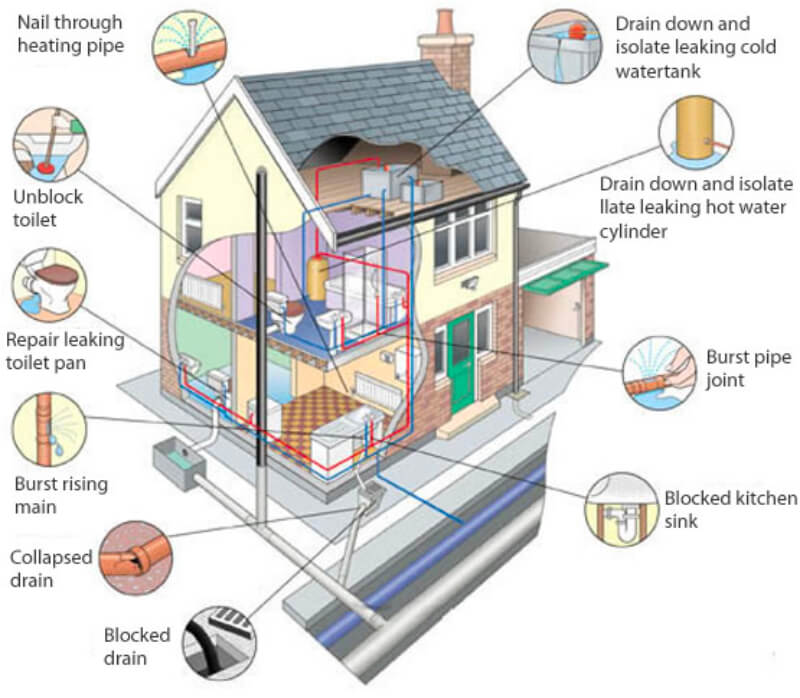Plumbing
Plumbing
Whether its a burst pipe, installing plumbed appliancies, Nick is reliable, friendly and delivers professional plumbing services throughout Hull and the surrounding villages, offering advice and supplying a competitive, no obligation quote. For more information, Call Nick Milner now on:
07967 525365 / 01482 703556
Helping you deal better with plumbing Emergencies …
Prevention
Drips, leaks and floods… If hot or cold water starts flooding out of any pipework, then turn off your stopcock immediately (clockwise). Stopcocks seize up if left untouched for too long, so turn it off and on again every six months. If it doesn’t turn off (clockwise), a pair of pliers will give you more leverage, but never force it too hard as stopcocks can shear off and cause a real flood.
Top tip
Next time Nick or another plumber is in the house, ask which other valves will isolate hot or cold water, and label them. This will help in emergencies.
If you can’t find a stopcock inside the house, then there should be one outside the house, often under a little trapdoor on the pavement. However, these can often by deep, stiff to turn, or buried under earth. You can phone your Yorkshire water authority if it won’t turn, as it is their responsibility.
Their customer helpline can be reached on 0845 1 24 24 24 or from their address at
Yorkshire Water
PO Box 52
Bradford
BD3 7YD
Of course it is better to do this before an emergency arises!
The stopcock won’t instantly stop the leak if it is fed by a cold-water tank in the loft or from a hot water cylinder in your airing cupboard. However, look out for other stopcocks or valves near the bottom of the tank or the top of the cylinder and try to turn them off. (Remember which ones you turn off so you can turn them on again later).
As well as standard stopcocks, other common valves are the gate valve, ballafix and lever valve
Gate Valves
Gate valves turn off clockwise (it takes many turns – be careful as the wheel has a habit of tearing off if treated roughly). Ballafixes are turned off using a screwdriver to rotate the screw on the front 90º so that the screw is across the pipe. Lever valves are turned off by twisting the lever 90º so that the lever is across to the pipe. Toilets and basins often have their own valve nearby so you won’t have to turn off the water to the whole building. If the ceiling starts to bulge then put a hole in it with a broom handle to prevent the weight of the water bringing it down on your head, then collect the water in a bucket.
If you need to empty your tank in a hurry, then turn off the mains water at the stopcock and run your bath taps – they normally have the thickest pipes. If you can’t find the main stop cock, then go into the loft and wedge the ball cock arm up using a stick or a piece of string – this will stop any more water entering the tank.
Dealing with taps and shower valves
Modern taps are not the same as older ones with different fitting so fixing a drip is not always a case of simply changing the washer. This is the case if you have a tap which turns from full off to full on with a quarter twist of the handle. Shower valves can also be complicated, and unless your shower is part of your bath taps. Please let me know the manufacturer and model of your shower valve before I can fix it. This may mean that fixing a dripping (modern) tap or shower takes two visits to your home: one to identify the make and model and one to fix replacement to the damaged parts.
other tips
Don't
Don’t ever try to drain the tank via the cold tap in the kitchen sink as this is normally connected straight onto the mains so not fed by the tank in the loft. If you have a new kitchen or bathroom fitted, then ensure your plumber fits isolation valves to all appliances, and that the installer leaves easy access to replaceable parts so you can get to them in an emergency without having to break through marble tiles or solid floor.
DO
Top tips bathroom/ Kitchen
If you have a new kitchen or bathroom fitted, then ask me to fit isolation valves to all appliances. This leaves easy access to replaceable parts so you can get to them in case of an emergency, and without having to break through marble tiles or solid floors.

